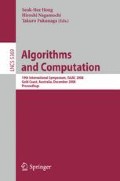Abstract
We initiate the study of the algorithmic foundations of games in which a set of cops has to guard a region in a graph (or digraph) against a robber. The robber and the cops are placed on vertices of the graph; they take turns in moving to adjacent vertices (or staying). The goal of the robber is to enter the guarded region at a vertex with no cop on it. The problem is to find the minimum number of cops needed to prevent the robber from entering the guarded region. The problem is highly non-trivial even if the robber’s or the cops’ regions are restricted to very simple graphs. The computational complexity of the problem depends heavily on the chosen restriction. In particular, if the robber’s region is only a path, then the problem can be solved in polynomial time. When the robber moves in a tree, then the decision version of the problem is NP-complete. Furthermore, if the robber is moving in a DAG, the problem becomes PSPACE-complete.
Access this chapter
Tax calculation will be finalised at checkout
Purchases are for personal use only
Preview
Unable to display preview. Download preview PDF.
References
Isaacs, R.: Differential games. A mathematical theory with applications to warfare and pursuit, control and optimization. John Wiley & Sons Inc., New York (1965)
Nowakowski, R., Winkler, P.: Vertex-to-vertex pursuit in a graph. Discrete Math. 43(2-3), 235–239 (1983)
Quilliot, A.: Some results about pursuit games on metric spaces obtained through graph theory techniques. European J. Combin. 7(1), 55–66 (1986)
Aigner, M., Fromme, M.: A game of cops and robbers. Discrete Appl. Math. 8(1), 1–11 (1984)
Lund, C., Yannakakis, M.: On the hardness of approximating minimization problems. J. of the ACM 41(5), 960–981 (1994)
Nahin, P.J.: Chases and escapes. The mathematics of pursuit and evasion. Princeton University Press, Princeton (2007)
Alspach, B.: Searching and sweeping graphs: a brief survey. Matematiche (Catania) 59(1-2), 5–37 (2006)
Fomin, F.V., Thilikos, D.M.: An annotated bibliography on guaranteed graph searching. Theor. Comp. Sci. 399, 236–245 (2008)
Goldstein, A.S., Reingold, E.M.: The complexity of pursuit on a graph. Theoret. Comput. Sci. 143(1), 93–112 (1995)
Fomin, F.V., Golovach, P., Kratochvíl, J.: On tractability of Cops and Robbers game. In: 5th Ifip International Conference On Theoretical Computer Science, vol. 273, pp. 171–185. Springer, Heidelberg (2008)
Edmonds, J., Karp, R.M.: Theoretical improvements in algorithmic efficiency for network flow problems. J. ACM 19(2), 248–264 (1972)
Fomin, F.V., Golovach, P.A., Hall, A., Mihalák, M., Vicari, E., Widmayer, P.: How to guard a graph? Technical Report 605, Dep. of Comp. Sc., ETH Zurich (2008), http://www.inf.ethz.ch/research/disstechreps/techreports
Brandstädt, A., Le, V.B., Spinrad, J.P.: Graph classes: a survey. SIAM Monographs on Discrete Mathematics and Applications. SIAM, Philadelphia, PA (1999)
Grötschel, M., Lovász, L., Schrijver, A.: The ellipsoid method and its consequences in combinatorial optimization. Combinatorica 1, 169–197 (1981)
Garey, M.R., Johnson, D.S.: Computers and intractability. A guide to the theory of NP-completeness, A Series of Books in the Mathematical Sciences. W. H. Freeman and Co, San Francisco (1979)
Downey, R.G., Fellows, M.R.: Parameterized complexity. Monographs in Computer Science. Springer, New York (1999)
Berarducci, A., Intrigila, B.: On the cop number of a graph. Adv. in Appl. Math. 14(4), 389–403 (1993)
Hahn, G., MacGillivray, G.: A note on k-cop, l-robber games on graphs. Discrete Math. 306(19-20), 2492–2497 (2006)
Raz, R., Safra, S.: A sub-constant error-probability low-degree test, and a sub-constant error-probability PCP characterization of NP. In: Proceedings of the 29th STOC, pp. 475–484 (1997)
Author information
Authors and Affiliations
Editor information
Editors and Affiliations
Rights and permissions
Copyright information
© 2008 Springer-Verlag Berlin Heidelberg
About this paper
Cite this paper
Fomin, F.V., Golovach, P.A., Hall, A., Mihalák, M., Vicari, E., Widmayer, P. (2008). How to Guard a Graph?. In: Hong, SH., Nagamochi, H., Fukunaga, T. (eds) Algorithms and Computation. ISAAC 2008. Lecture Notes in Computer Science, vol 5369. Springer, Berlin, Heidelberg. https://doi.org/10.1007/978-3-540-92182-0_30
Download citation
DOI: https://doi.org/10.1007/978-3-540-92182-0_30
Publisher Name: Springer, Berlin, Heidelberg
Print ISBN: 978-3-540-92181-3
Online ISBN: 978-3-540-92182-0
eBook Packages: Computer ScienceComputer Science (R0)

